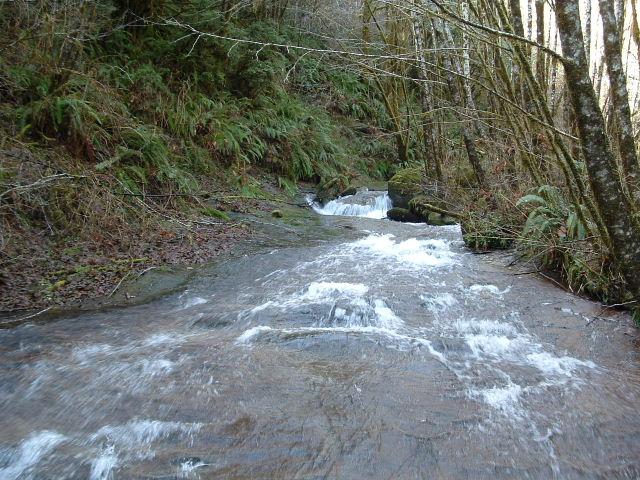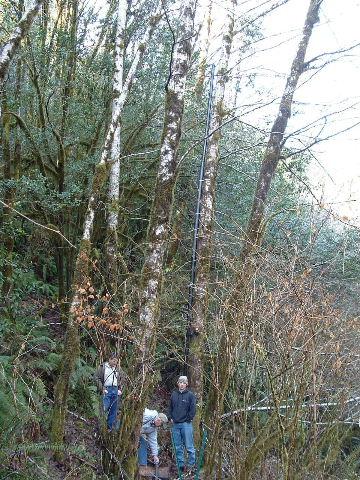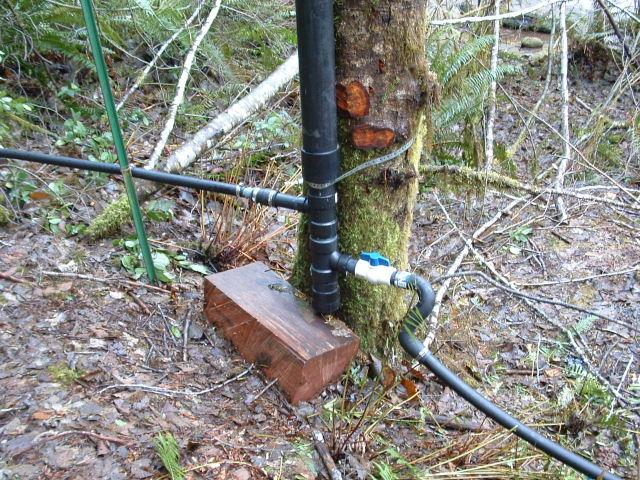I actually do not have my intake built yet, but just a screen
to keep out leaves. I'll put an image of the intake when it's
done, but for now, here is a picture of 'Shoemaker Creek' to
impress upon the reader the grade. As I say, I am lucky to have
such an ideal situation!

Note: I came down the hill with 1.25 line. Since the run is
only 300', this is OK in my application. I get better than 7
gpm flow at the bottom of the stand-pipe, but ***this is wrong
thinking!*** The head causing water to flow will be the drop
between the intake and the top of column of water in the stand
pipe. When they are equal, there will be *NO* flow, thus, the
column will drop when the pump is in operation. This drop
will be a function of the resistance in the line (length and
diameter) and of the flow rate (size of the pump.) Think this
one through and don't be a cheapskate like me if you have a less
ideal site!
The steep grade of the river made it possible for me to run the
pump with around 25' of head minus whatever drop hapens in the
column in the stand-pipe, hence the rather tall stand-pipe that
one can see going up the tree:.

Note: Most of this stand-pipe is 4 inch which is just barely
sufficient for a 1.25 drive-pipe. I cheated and used a section
of 3 inch at the top because I have head to spare and an extra drop
in the column (when the pump exhasts) won't hurt me to much. I
only cheated here because the tall stand-pipe was awkward to
handle.
By the way, it's probably worth it to *not* simply
guess how high the stand-pipe needs to be and come up short like
I did (twice!) I could have simply run the line up the tree
until water stopped comming out to see how high I needed to make
the stand-pipe, but noooo...I ended up taking it down and going
to town for more sewer pipe.
This is the base of the stand-pipe.

Note_1: The intake is higher than the outflow to the
pump so that if somehow air bubbles enter the intake, they will
float up and not get in the pump where they have a very negative
impact.
Note_2: The valve is optional, but very nice to have, at
least initially when fooling with the pump.
Note_3: The isolation tube which is an auto part in my
case is very important in my opinion. Even a well secured pump
(as mine is as you will see) will have some movement, and it can
fatigue the stand-pipe assembly.
Note_4: I have a 'rock chamber' at the bottom of my
stand-pipe assembly...it remains to be seen if I will be able
to unscrew the silly thing at some point in the future to clean
it?
Note_5: I have a 6 foot section of 1.5 inch plastic pipe
between the 1.25 inch steel drive-pipe and the stand pipe. This
is not ideal, and is an artifact of my repositioning things.
Try to set the pump up so that this is not necessary, and if
it is, consider using something larger than a 1.5 inch pipe.
You don't want it to be an extention of the drive pipe (by
developing it's own water-hammer effect.) This is a source
of angst for me since I basically understand how the pressure
waves are supposed to behave in the drive-pipe. I thought about
aranging an isolation mechanism between the offending plastic
section and the drive-pipe (like, say, an inner-tube bag) but as
it happens, things are working OK in the current configuration
so I don't need to bother...and probably won't.
Back



